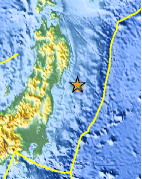December 5, 2013
Fault That Caused Japan's 2011 Earthquake Is Thin and Slippery
![]()

Scientists had to use a remotely operated vehicle to retrieve temperature sensors from a borehole drilled into the Japan Trench, 6,900 meters below the surface of the Pacific Ocean. Image courtesy of JAMSTEC.
The magnitude 9.0 Tohoku-Oki earthquake that struck Japan on 11 March 2011, killing more than 15,000 people and setting off a devastating tsunami that the nation is still working to recover from, brought up a lot of troubling questions. For instance, what made such a powerful earthquake possible, and could it happen again in Japan or somewhere else?
An international group of scientists that drilled miles beneath the Pacific Ocean and into the earthquake fault now have answers to these questions, and they report their findings in a trio of papers published today in Science.
The epicenter of the 2011 quake was in an unusual spot, about 130 kilometers east of Sendai, Japan, just off the northern coast of that nation. In this area, a subduction zone, the Pacific plate is diving beneath the Eurasian plate. Strong earthquakes are possible here, but scientists hadn't thought that there was enough energy to produce one larger than magnitude 7.5. They were wrong, and they've been interested in finding out more about what made the fault capable of producing such a large quake.

The epicenter of 2011 Tohoku-Oki earthquake was off the east coast of northern Japan. Image via USGS
A little over a year after the earthquake, the deep sea drilling vessel Chikyu was tasked with the mission to drill into the fault off the Japanese coast and install a temperature observatory. By taking the temperature of a fault after an earthquake, scientists can measure how much energy was released in the quake and calculate a fault's friction—how easily the rocks rub against each other.
"One way to look at the friction of these big blocks is to compare them to cross-country skis on snow," Robert Harris, a study co-author and geophysicist at Oregon State University, said in a statement. "At rest, the skis stick to the snow and it takes a certain amount of force to make them slide. Once you do, the ski's movement generates heat and it takes much less force to continue the movement…. The same thing happens with an earthquake."
Getting that temperature measurement was tricky. The Chikyu team had to drill 850 meters into the seafloor, which itself was 6,900 meters below the ocean's surface. They had to deal with bad weather, and the fault itself was still shifting, putting the instruments at risk.
The difficult work paid off, though, and it revealed residual heat from the earthquake, from which the scientists could calculate the fault's friction, which was very low. Bottom line: "The Tohoku fault is more slippery than anyone expected," Emily Brodsky, a study co-author and geophysicist at the University of California, Santa Cruz, said in another statement.
The slippery nature of the fault helps to explain some characteristics of the 2011 quake. The fault slipped an unprecedented 50 meters and the rupture, which began deep underground, reached the surface where it caused a sudden disturbance in the ocean and set off the tsunami.
The drilling and laboratory tests also revealed another characteristic of the fault that made it so dangerous. The low friction can be attributed to incredibly fine clay sediment within the fault. "It's the slipperiest clay you can imagine," Christie Rowe, a study co-author and geologist at McGill University, said in a statement. "If you rub it between your fingers, it feels like a lubricant." Incidentally, the area between the Pacific and Eurasian plates that experiences slip is also very thin, less than five meters across, which would make it the thinnest known fault zone on the planet.
Measuring the earthquake's thermal signal was a first for science. It "was a major accomplishment," Harris said, "but there is still a lot we don't yet know." For example, researchers don't yet know how generalizable these results are to other subduction zones across the world or what effect the thinness of fault zones has on earthquake hazards. Nonetheless, the drilling results "suggest that the shallow megathrust at the Japan Trench has special traits not seen in many other subduction zones," Kelin Wang of Natural Resources Canada and Masataka Kinoshita of the Japan Agency for Marine-Earth Science and Technology—the agency that runs the Chikyu—wrote in an accompanying Perspectives article.
Similar conditions may be rare, but they do exist in some places of the north Pacific, such as the Kamchatka Peninsula in Russia and the Aleutian Islands in Alaska, notes Rowe.Deep sea drilling shows that these regions have that same usually slippery clay that lowered the friction in the Japan fault.
But the fact that the unusual circumstances of the Japan fault may be rare shouldn't put scientists, or the public, at ease, Wang and Kinoshita say. Such huge, shallow slip isn't necessary for a devastating tsunami to form, and it wasn't what caused either the 2010 Chile tsunami that destroyed 370,000 homes or the 2004 Indian Ocean tsunami that killed nearly 230,000 people. "It's hard to say how generalizable these results are until we look at other faults," Brodsky added. "But this lays the foundation for a better understanding of earthquakes and, ultimately, a better ability to identify earthquake hazards."
--
__._,_.___
No comments:
Post a Comment